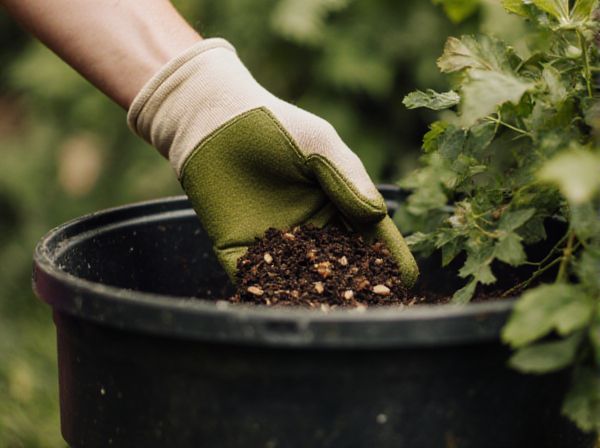
Tumbler Composting vs Static Pile Composting Illustration
Tumbler composting accelerates decomposition by improving aeration and ease of turning, making it ideal for small spaces and frequent use. Static pile composting requires less effort but relies on natural microbial activity, suitable for larger volumes and less regular maintenance. Both methods produce nutrient-rich compost, but choice depends on time availability, space, and user intervention preferences.
Table of Comparison
| Feature | Tumbler Composting | Static Pile Composting |
|---|---|---|
| Design | Sealed drum that rotates to mix organic waste | Fixed pile of organic materials, no rotation |
| Aeration | Automatic through tumbling action | Manual, requires turning with pitchfork or aeration tools |
| Composting Speed | Fast, typically 2-4 weeks | Slow, usually 2-6 months |
| Maintenance | Low, simple turning process | Moderate to high, frequent pile turning needed |
| Space Requirements | Compact, suitable for small yards | Large area needed for pile expansion |
| Ideal for | Household organic waste, beginners | Large volume garden waste, experienced composters |
| Odor Control | Better sealed system minimizing odors | Can emit odors if not properly managed |
| Pest Control | Enclosed design deters pests | Open piles attract pests without barriers |
Introduction to Tumbler and Static Pile Composting
Tumbler composting involves a rotating drum that aerates organic waste, speeding up decomposition through increased oxygen flow and ease of mixing. Static pile composting relies on a stationary heap of organic material that decomposes naturally, requiring passive aeration and occasional manual turning to maintain airflow. Both methods effectively recycle organic waste but differ in maintenance frequency, decomposition speed, and space requirements.
How Tumbler Composting Works
Tumbler composting works by placing organic waste inside a rotating drum that is periodically turned to aerate the materials, speeding up decomposition. The rotation ensures even mixing of greens and browns, promoting efficient microbial activity and maintaining optimal oxygen levels. This method reduces composting time to a few weeks compared to static pile composting, which relies on manual turning and slower natural aeration.
How Static Pile Composting Works
Static pile composting involves creating a large, unmoved heap of organic waste where natural microbial activity breaks down materials over time. Proper aeration is maintained by turning the pile occasionally or integrating bulking agents that promote airflow, supporting efficient decomposition. Moisture levels and temperature must be monitored regularly to optimize microbial activity and accelerate compost maturation.
Efficiency and Composting Speed Comparison
Tumbler composting significantly enhances oxygen circulation and moisture distribution, resulting in faster decomposition and more efficient compost production compared to static pile composting. Static piles rely on natural aeration and require manual turning to prevent slowdowns caused by compacted material, often extending the composting process by weeks. The accelerated breakdown in tumblers reduces composting time from several months to just a few weeks, making them ideal for users seeking rapid nutrient-rich soil amendments.
Space Requirements: Tumblers vs Static Piles
Tumbler composting requires significantly less space than static pile composting, making it ideal for small yards or urban settings. Tumblers are compact, enclosed units that allow efficient aeration and mixing in a confined footprint, typically around 3 to 6 cubic feet. Static piles demand larger, open areas--often several cubic yards--to facilitate natural decomposition and manual turning, limiting their suitability in space-restricted environments.
Maintenance and Labor Needs
Tumbler composting requires regular turning and moderate physical effort to ensure aeration and faster decomposition, making it ideal for users seeking controlled maintenance. Static pile composting demands minimal labor, relying on passive aeration and natural microbial activity, but may need occasional manual turning to prevent odor and optimize breakdown. Both methods differ significantly in maintenance intensity, with tumbler systems offering convenience at the cost of frequent handling and static piles suiting low-effort composters.
Odor and Pest Control: Pros and Cons
Tumbler composting offers superior odor control by facilitating regular aeration and faster decomposition, which reduces anaerobic conditions that cause foul smells. Static pile composting may emit stronger odors due to limited airflow, increasing the risk of attracting pests like rodents and flies unless properly managed with frequent turning and covering. While tumbler systems provide better pest deterrence through sealed containers, static piles require strategic site placement and maintenance to minimize odor and pest issues effectively.
Cost Analysis: Investment and Long-term Savings
Tumbler composting systems require a higher initial investment, typically ranging from $100 to $300 for quality units, but they offer faster decomposition and reduced labor, leading to long-term savings in time and maintenance. Static pile composting involves minimal upfront costs, often just the price of materials for bin construction or designated land, but it demands more manual effort and longer composting periods, potentially increasing indirect costs. Over time, the efficiency and ease of using a tumbler can offset its higher initial expenditure through quicker compost turnover and reduced labor.
Quality of Finished Compost
Tumbler composting produces consistently aerated and well-mixed material, resulting in high-quality, fine-textured compost with faster decomposition rates and fewer odor issues. Static pile composting often produces uneven compost quality due to limited aeration and slower microbial activity, which can create coarse, under-decomposed patches. Optimal compost quality from static piles requires regular manual turning and moisture control to enhance microbial processes and uniform breakdown.
Choosing the Best Composting Method for Your Garden
Tumbler composting offers faster decomposition by allowing regular turning and aeration, ideal for gardeners seeking quick and odor-controlled compost production. Static pile composting suits larger gardens with ample space, relying on natural breakdown processes that require minimal maintenance but longer composting time. Selecting the best method depends on garden size, available effort, and composting speed preferences to optimize nutrient-rich soil amendment.
Tumbler Composting vs Static Pile Composting Infographic

 gardendif.com
gardendif.com